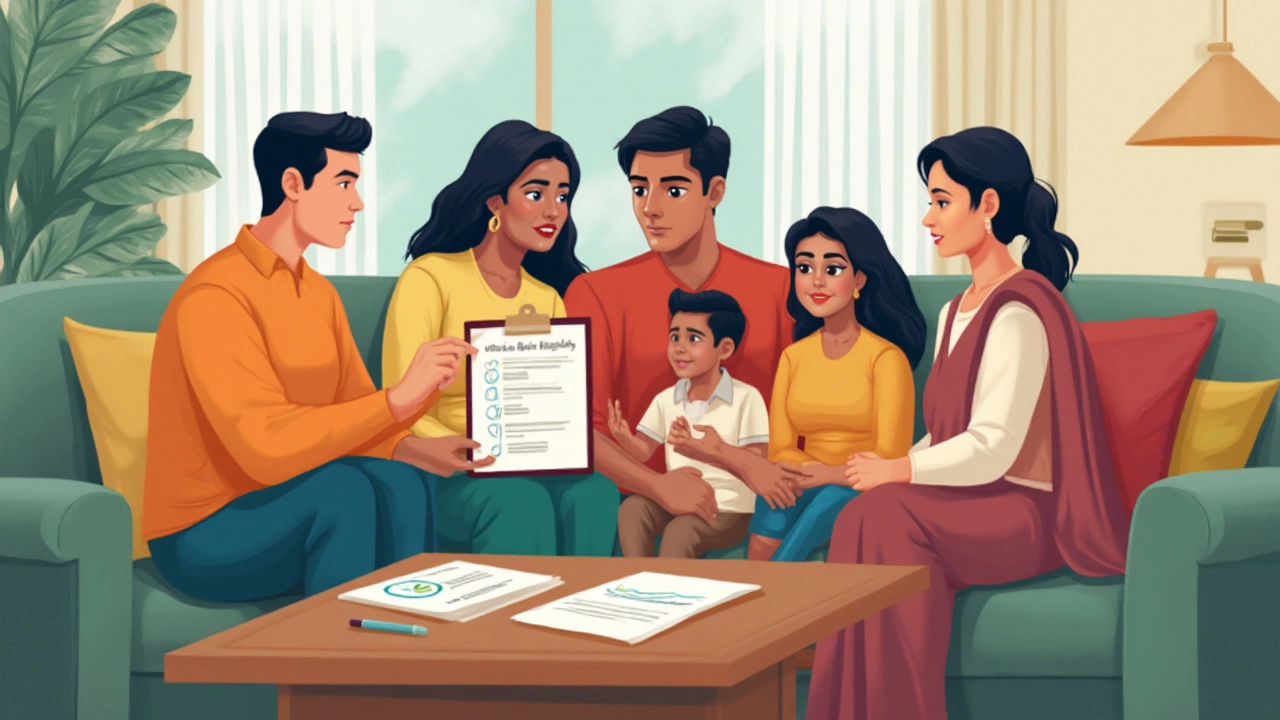Ever feel like you’re stuck between a rock and a hard place, taking care of your aging parents while juggling work, bills, and everything else life throws at you? You’re not the only one. Loads of people find themselves caring full-time for mom or dad, but they wonder if there’s a way to get paid for what seems like a round-the-clock job.
Here’s a fact that surprises a lot of folks: In some cases, you can actually get paid to be your parent's caregiver. The rules, though, aren’t the same for everyone—it depends a lot on where you live, what health issues your parent faces, and what programs apply. Medicaid is usually the big player here, especially with its state-run options. If you’re curious whether you’ll qualify, or want to know how to even start looking, stick with me. I’ll lay it all out in plain English so you don’t waste time chasing dead ends.
- Why People Look for Paid Family Caregiver Programs
- Medicaid and State-Based Options
- Veterans’ Programs and Other Federal Support
- Tax Breaks and Alternative Financial Support
- How to Qualify and Apply
- Tips for Managing Care and Payment
Why People Look for Paid Family Caregiver Programs
A lot of families end up paying out of pocket when a parent needs help at home. Professional care is expensive—some home health aides charge more than $25 an hour, and full-time care can add up to thousands per month. Most people want to keep their parents out of nursing homes, but quitting your job or cutting back hours isn’t always an option. That’s where the idea of getting paid as a family caregiver comes in.
People look for these programs for a few reasons:
- Financial relief: Many adults can’t afford to give up their paycheck, especially if they’ve got kids, a mortgage, or student loans. Getting paid as a caregiver can help cover bills and day-to-day costs.
- Keeping parents at home: Most seniors want to stay in their own homes. Family care can give the comfort and personal attention that’s tough to find in facilities. But it can be a full-time job, and that energy should be recognized and supported.
- Better quality of life for everyone: When you’re less stressed about money, family time doesn’t feel so rushed. There’s space for compassion and patience instead of burnout.
| Type of Care | National Median Monthly Cost (2024) |
|---|---|
| Nursing Home (private room) | $9,500 |
| Assisted Living Facility | $4,774 |
| Home Health Aide (44 hours/week) | $5,100 |
Almost 1 in 5 Americans provides unpaid care to an adult family member. That’s over 48 million people trying to balance life, work, and caregiving, according to the AARP. If you’re in that boat, it’s normal to ask if elderly care programs or even Medicaid offer a way to help with some of the load.
Medicaid and State-Based Options
If you want to get paid as a family caregiver, Medicaid is usually the main road. But here’s the catch: every state does things their own way. Some are generous, others not so much. Medicaid’s big deal here is the “Self-Directed Care” or “Consumer-Directed” models—these let people decide who gets paid for their care, and yes, family can sometimes be chosen.
In California, for example, there’s the In-Home Supportive Services (IHSS) program. If your parent qualifies, the state can pay you to help them with things like cooking, bathing, or trips to the doctor. New York has something similar called CDPAP (Consumer Directed Personal Assistance Program), where you can not only get paid, but even give medication if needed.
For a lot of states, here’s how it works:
- The older adult must qualify for Medicaid, which usually means limited income and assets.
- You typically need an assessment by a nurse or social worker, who decides what kind of help is needed and how many hours you’ll get paid for.
- Once set up, the person needing care (your parent) picks their caregiver—you can apply as their paid aide.
Here’s a simple table to give you a quick sense of the variety just between states:
| State | Program | Can Family Be Paid? |
|---|---|---|
| California | IHSS | Yes |
| New York | CDPAP | Yes |
| Florida | Statewide Medicaid Managed Care (SMMC) | Usually |
| Texas | Community Attendant Services (CAS) | Depends |
Some states make you sign up through an official agency; others let you work as an “independent provider.” The pay rate isn’t huge, but it’s better than being unpaid for hours you’d spend caring for your parent anyway. According to the AARP, "The median pay for family caregivers through Medicaid self-directed programs can range from minimum wage up to $15 or more per hour, depending on the state."
“Giving families the option to be paid caregivers offers dignity and support to those juggling work and caregiving at home.” — AARP Public Policy Institute
If you want to start this process, head to your local Medicaid office or look for your state’s name plus “self-directed care” online. Each program is different, so don’t be surprised if the paperwork gets a little wild. Grab every document you can—including proof of Medicaid and your parent’s medical needs—to make things smoother.
Veterans’ Programs and Other Federal Support
If your parent is a veteran—or married to one—you definitely have extra options. The Department of Veterans Affairs (VA) actually pays family members to look after their loved ones in some cases. This isn’t just a rumor. It’s real money, coming from a couple of main elderly care programs.
First, check out the VA’s Aid and Attendance benefit. This adds extra money to a veteran’s monthly pension if they need daily help. The veteran can use this extra income to pay a family caregiver—that could be you. To qualify, they must already get a VA pension and meet specific health needs, like needing help with bathing or eating. There’s also an asset and income test, so not every family will qualify, but the application is free.
Another big one is the Program of Comprehensive Assistance for Family Caregivers. This is for veterans seriously injured in the line of duty after September 11, 2001 (and, slowly, for those injured before 1975 as well). If you qualify, the VA pays you a monthly stipend, covers health insurance, gives you training, and even offers mental health counseling. The exact amount you get depends on where you live and the level of care your parent needs.
- For Aid and Attendance, apply through the VA Pension Management Center or local VA office.
- For the Family Caregiver Program, apply online through the VA’s caregiver portal, or call your nearest VA Medical Center for help.
Not sure where to start? The VA has a Caregiver Support Line at 1-855-260-3274. They can walk you through the process so you don’t have to guess.
Outside of the VA, there aren’t many other direct paid caregiver options from the federal government. Medicare, for example, usually won’t pay family members to provide care. But if your parent is a veteran, these VA benefits can be game changers.
| Program | Who Can Qualify | What’s Provided |
|---|---|---|
| VA Aid and Attendance | Veterans/widows with daily care needs | Extra monthly payments for care |
| VA Family Caregiver Support | Family caring for post-2001 (or pre-1975) injured vet | Stipends, training, health insurance |
Bottom line: If your parent served in the military, or is the widow of someone who did, don’t leave these options on the table. With elderly care getting more expensive, VA programs can help your family out big time.

Tax Breaks and Alternative Financial Support
If you’re not getting paid as a family caregiver through Medicaid or another program, you might still get some relief at tax time or through other support. The IRS doesn’t directly pay you, but there are a couple of breaks that can put real money back in your pocket.
First, if your parent lives with you and you cover more than half their support, you might be able to claim them as a dependent. This can lower your taxable income. For 2024, you can’t claim the old personal exemption, but you might still qualify for the Credit for Other Dependents, worth up to $500. To get this, your parent must meet certain income limits (under $4,700, not counting non-taxable Social Security), and they must be either a U.S. citizen or resident alien.
Another big one: the Dependent Care Credit. Let’s say you pay for things like adult day care so you can go to work: you could get up to 35% of $3,000 (for one parent) or $6,000 (for two parents) in credit, depending on your income. This isn’t a direct payment, but when you’re doing taxes, every bit helps.
- Medical Expense Deduction: If you itemize, you can deduct unreimbursed medical expenses for your parent, as long as everything over 7.5% of your adjusted gross income (AGI) counts. This includes stuff like home modifications and medical equipment—expenses that add up fast.
- Flexible Spending Accounts (FSAs): Some employers let you use FSA funds to cover dependent care. While not everyone has this, it’s worth checking your benefits at work if you’re spending on care.
Beyond the IRS, there are a few other spots to look for help:
- Long-Term Care Insurance: If your parent bought a policy, you can use it to pay yourself for caregiving if the policy allows. The details are in the fine print, so always double-check.
- State and Local Support: Some local governments pitch in with small stipends or caregiver grants. These don’t make anyone rich, but they’re worth looking into—sometimes through your local Area Agency on Aging.
- Employer Assistance: A few big employers offer paid caregiver leave or referral services. It’s rare, but it exists, so poke around HR paperwork or ask your boss.
Check out this quick table showing what you might be eligible for if you’re a paid caregiver in the U.S.:
| Support Option | Who Qualifies | Payout/Benefit |
|---|---|---|
| Dependent Care Credit | Caretakers who pay for adult day care to work | Up to $1,050 per parent |
| Credit for Other Dependents | Parent meets residency and income rules | Up to $500 per parent |
| Medical Expense Deduction | Itemizers with big out-of-pocket costs | Amounts over 7.5% of AGI |
The bottom line: Most of this stuff won’t replace a salary, but it does cut costs or give you a little breathing room. Double-check the latest IRS details and track your spending. Sometimes the small stuff—like a $500 credit—actually matters when you’re shouldering a lot to help your family.
How to Qualify and Apply
So, you’re ready to look into actually getting paid for being a family caregiver. Here’s how to make this real, without sliding into government form hell. There are a few proven routes, but the most common way starts with Medicaid—and a few other programs specific to elderly home care.
Medicaid Waiver Programs are the big ones. These let states pay family members (sometimes even adult kids) for personal care services in the home. But not all states offer the same program, and not all states pay family. To get started, check if your state has a Medicaid Home and Community Based Services (HCBS) Waiver, also called a "Cash and Counseling" or "Self-Directed Care" program.
- First step: See if your parent qualifies for Medicaid based on income and assets. Every state has its own cutoff, but for 2025, adults usually need income below $2,829 a month and assets under $2,000 to $3,000 (outside of their primary home).
- Next: Your parent will go through an assessment process. This usually means a nurse or social worker visits and checks what kind of help your parent needs—like dressing, bathing, meals, and getting around.
- Apply for the program: Ask your local Medicaid office about self-directed care or consumer-directed services forms. Sometimes you’ll need to name yourself or another family member as the “caregiver.”
- Training and paperwork: You’ll probably have to do basic training and fill out timesheets, just like a regular paid caregiver.
Other options? If your parent is a veteran, check out the VA’s Aid & Attendance pension or the Veteran-Directed Home and Community Based Services program. These offer monthly cash help or give vets control over their own caregiver budget (which can include paying you).
Outside government programs, some long-term care insurance policies let family members get paid, especially if the company sees home care as legit. Ask your parent’s insurance agent up front.
For the numbers people, here’s a quick look at average Medicaid home care payments by state, according to a survey from 2024:
| State | Avg. Hourly Payment | Family Allowed? |
|---|---|---|
| Pennsylvania | $14.50 | Yes |
| Texas | $13.25 | Yes |
| Florida | $12.80 | Sometimes |
| California | $16.00 | Yes |
| New York | $15.75 | Yes |
Bottom line: If you want to get paid to take care of your parents, you’ll need to get comfortable with forms, maybe some short training, and talking to a bunch of offices. But for many families, that monthly paycheck makes a real difference. It’s not always lightning fast, but it is doable.
Tips for Managing Care and Payment
Getting paid to be a family caregiver sounds like a win, but there’s a lot to keep track of, or you can end up missing out on money or help you deserve. Here’s what works best, based on what I’ve seen from real families and the latest info:
- Stay Organized: Keep a log of every hour you spend on elderly care—meals, meds, appointments. Programs like Medicaid often want proof you’re doing real work. Use a notebook, an app, or even your calendar.
- File Paperwork On Time: Most of these programs come with mounds of paperwork. Set reminders for every deadline. If you’re dealing with Medicaid or a paid caregiver program, late forms can set you back months.
- Document Expenses: Save receipts for anything related to your parent’s care, even things like gas for doctors’ visits or special food. These can help you with tax breaks or reimbursement requests.
- Know the Hour Limits: Some programs cap the hours you can get paid for per week. For example, certain state Medicaid waivers limit caregivers to 40 hours. If you go over, you might work for free, so check your state’s rules.
- Take Care of Yourself: Burnout’s real. Look for local respite care or adult daycare—that way you get a breather, and it’s often covered by the same programs paying you.
- Keep Learning: Join a caregiver support group (online or local). People there swap tips that aren’t in the official booklets—what documents to bring to Medicaid, or which forms slow things down.
Just how big is this world? Check this out:
| Number of Family Caregivers (US, 2024) | Estimated Value of Unpaid Care |
|---|---|
| ~53 million | $600+ billion/year |
So, you’re really not alone in this.
If you jump into a home care program, double-check if the payments count as taxable income—some do, some don’t. Keep records for IRS season, just in case. And if your parent is a Veteran, look for extra help through the VA’s Aid and Attendance and Housebound allowances.
Navigating it all isn’t easy, but if you treat it kind of like a part-time job with a mountain of paperwork, you’ll make fewer mistakes and maybe even keep a bit of your sanity.


